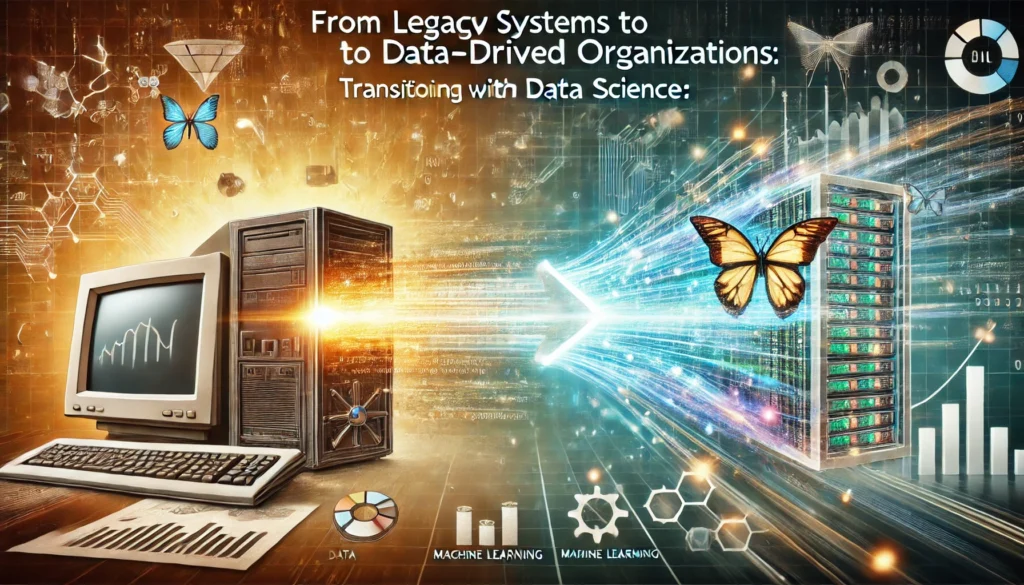
In today’s fast-paced digital economy, organizations are increasingly recognizing the limitations of legacy systems. While these systems may have once served as the backbone of operations, they now struggle to keep up with the demands of modern data analytics, cloud computing, and real-time decision-making. Transitioning from legacy systems to a data-driven organization is no longer optional—it’s essential for staying competitive. Data science and analytics are the catalysts that enable this transformation.
Why Transition from Legacy Systems?
Legacy systems, often built decades ago, are typically rigid, expensive to maintain, and incapable of integrating with modern technologies. They hinder:
- Data Accessibility: Fragmented and siloed data limits visibility and insights.
- Scalability: Outdated infrastructure cannot handle the growing volume of data.
- Agility: Slow processing and lack of integration impede real-time decision-making.
By adopting data science and analytics, companies can modernize operations, unlock the value of their data, and create a robust foundation for growth.
Steps to Transition with Data Science
- Assess Current Systems and Data
- Start by auditing legacy systems to understand their limitations and the structure of existing data.
- Identify key business goals that can be addressed through data analytics, such as improving customer experience or optimizing supply chains.
- Develop a Modern Data Infrastructure
- Data Integration: Use tools like ETL (Extract, Transform, Load) pipelines to consolidate siloed data into a centralized repository, such as a cloud-based data warehouse.
- Cloud Migration: Move data storage and processing to cloud platforms like AWS, Azure, or Google Cloud for scalability and flexibility.
- Leverage Data Science for Modernization
- Predictive Analytics: Use machine learning models to forecast demand, detect anomalies, and drive proactive decision-making.
- Real-Time Dashboards: Implement visualization tools like Tableau or Power BI to monitor performance metrics dynamically.
- Automation: Automate repetitive tasks like reporting and data entry to improve efficiency.
- Adopt a Data-Driven Culture
- Upskilling Teams: Train employees in data literacy and analytics tools.
- Collaborative Mindset: Encourage cross-functional collaboration between IT, data science, and business teams.
- Leadership Buy-In: Secure support from executives to champion the transition.
Real-World Examples of Transformation
- Retail Industry: A global retailer transitioned from spreadsheets to a data-driven platform. By leveraging data science, it gained insights into customer behavior, optimized inventory, and personalized marketing campaigns, resulting in a 20% increase in sales.
- Manufacturing: A factory using legacy systems for production tracking adopted IoT-enabled analytics. Data from sensors and predictive models reduced downtime and improved operational efficiency by 30%.
- Healthcare: A hospital system moved patient records from outdated software to a cloud-based analytics platform. This enabled real-time monitoring of patient outcomes and streamlined resource allocation.
Benefits of a Data-Driven Organization
- Enhanced Decision-Making: Data-driven insights replace guesswork with evidence-based strategies.
- Improved Efficiency: Automation and predictive analytics streamline operations, reducing costs.
- Scalability: Modern infrastructure supports growth and adapts to new business needs.
- Competitive Advantage: Organizations that harness the power of data gain an edge in innovation and customer satisfaction.
Overcoming Challenges
Transitioning from legacy systems comes with challenges, such as resistance to change, data migration complexities, and initial costs. However, these obstacles can be mitigated by:
- Clear Communication: Educate teams on the long-term benefits of modernization.
- Incremental Implementation: Start with small, high-impact projects to demonstrate value.
- Strategic Partnerships: Work with experienced data science consultants and cloud providers.
Conclusion: Embrace the Future with Data Science
The journey from legacy systems to a data-driven organization may seem daunting, but the rewards far outweigh the challenges. With data science as the driving force, businesses can unlock new levels of efficiency, innovation, and profitability.
Ready to modernize your organization and embrace data-driven strategies? Explore our Data Science programs from industry expert trainers to gain the skills needed for this transformation. Start today and lead the charge toward a more agile and competitive future.